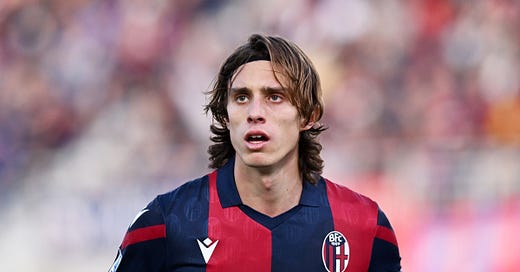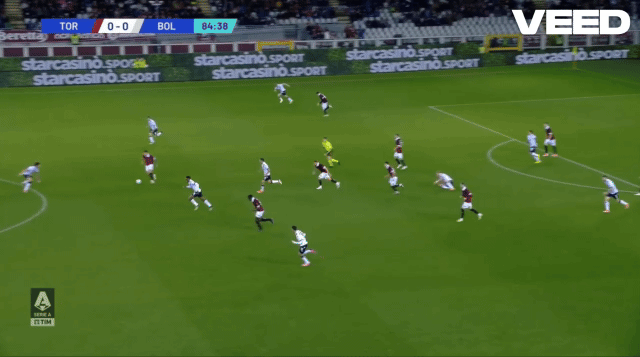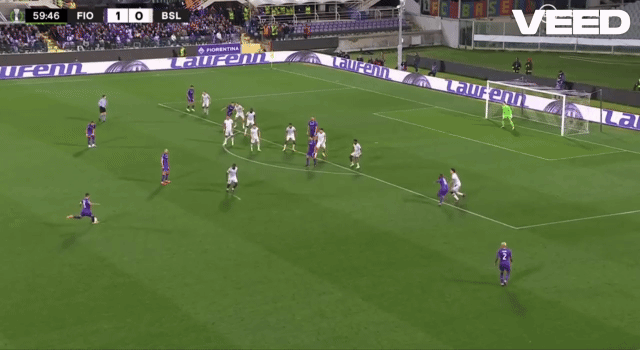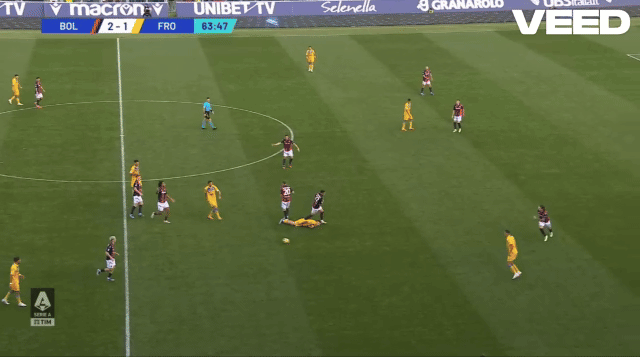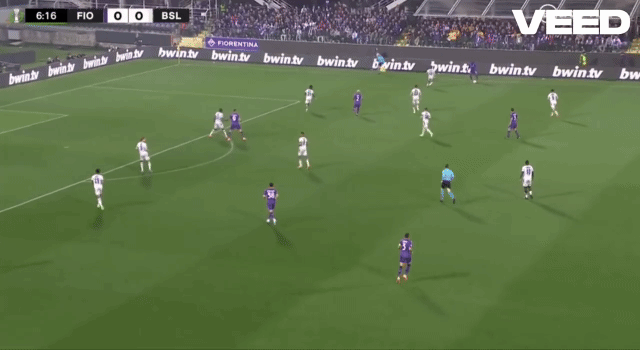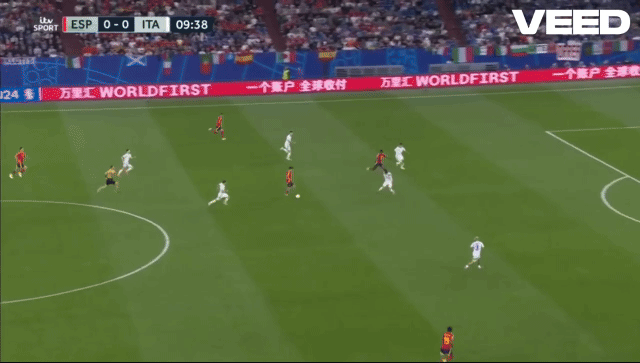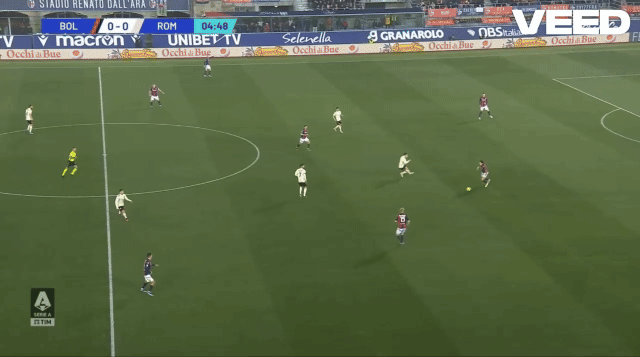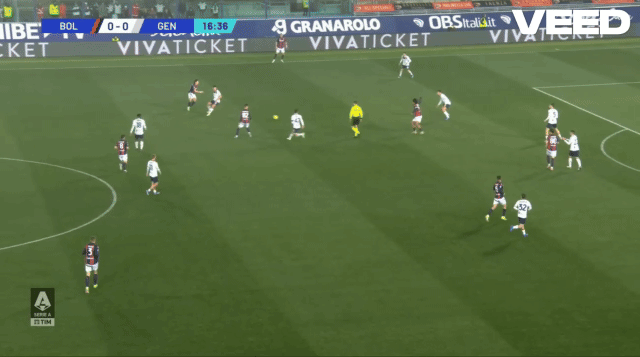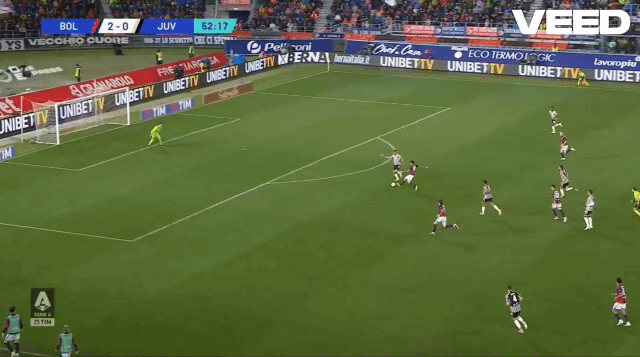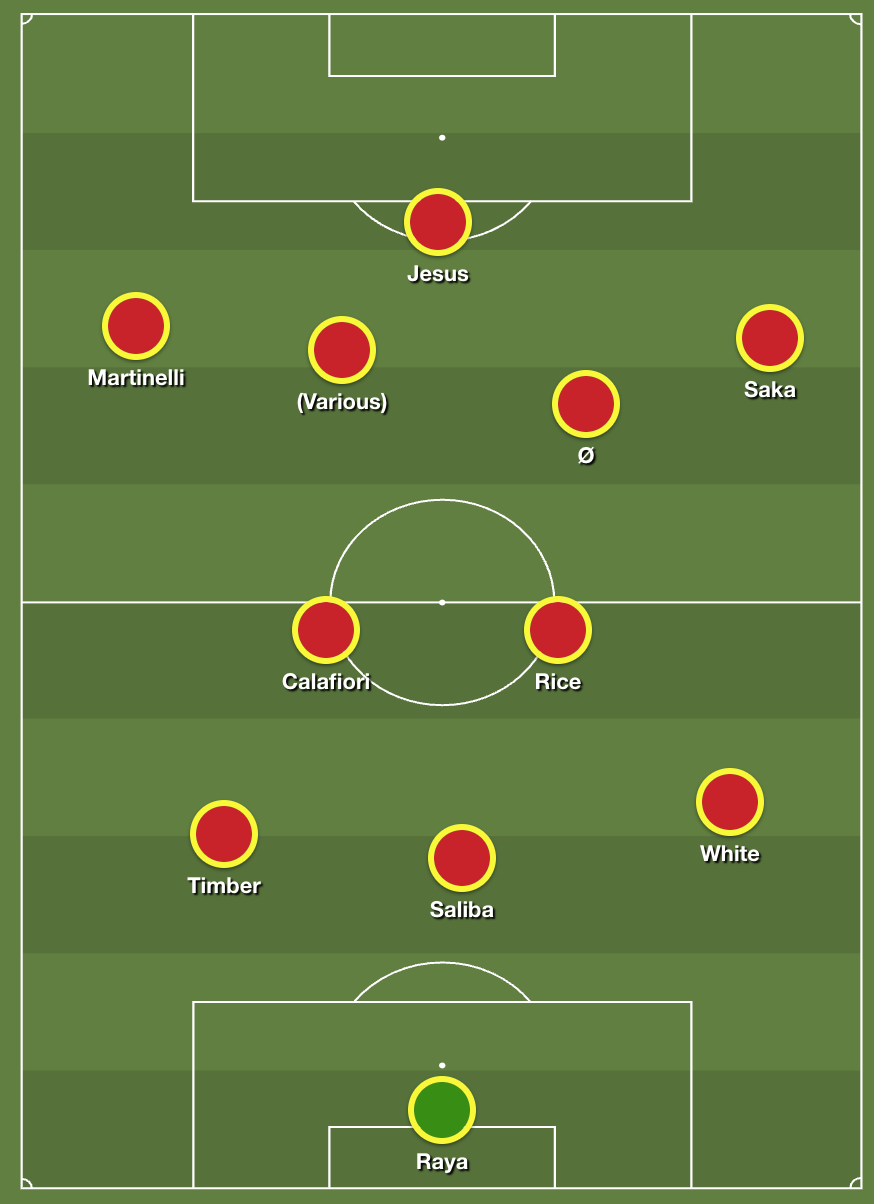Scouting Report: Riccardo Calafiori
Name: Riccardo Calafiori
Nationality: Italian
Club: Bologna FC 1909
Age: 22 (May 2002)
Position: CB/LB
Career Overview
Calafiori joined Roma’s youth set-up aged ten and signed his first contract with his boy-hood club in 2018, aged sixteen. In October of the same year, he was victim to a challenge that saw him tear every ligament in his left knee, yet somehow came back a year later. The Italian defender joined the first-team fold in 2020 but struggled to find regular game time, featuring mainly as a rotational left-back. After an unsuccessful short-term loan with Genoa starting in January 2022, Calafiori was sold to Basel in the summer for a fee of only €2.6m as well as a 40% sell-on clause.
Late in the season, Basel’s manager Heiko Vogel proposed repositioning Calafiori from full-back to centre-back — a change the player reportedly embraced enthusiastically.
The following summer, he was bought by Bologna for €4m, to be subsequently brought into the starting eleven in late September after an injury to Colombian centre-back Jhon Lucumí. He would never look back, achieving thirty-five appearances for the Italian outfit — twenty-nine at centre-back and six at left-back.
“For how I see football, I would like all my players like this” - Thiago Motta
Physical Profile
Measures 1.88m. Broad-shouldered.
Extremely mobile for his size. Impressive accelerator, especially when moving vertically. Not quite as at ease horizontally given his slightly broader frame.
Long legs and powerful quads, which give him good reach and a wide circle of control. Helps with interceptions, blocks and getting to loose balls.
Good running power, especially over the first ten to fifteen metres. Loses a bit of power over the longer distances.
A strong leaper — authoritative in the air.
Strong core strength. Can crouch low and remain mobile in 1v1 situations.
Elite “body-to-ball coordination” (see below for explanation) across different game situations to remain in control of his technical actions in dynamic/moving situations.
Out of Possession
Enters ground duels with ferocity and intent. Boasts a strong tackling technique. A wilful commitment to making contact with the ball in 1v1 situations — will watch the ball and not the player in moments of immediate defensive engagement. Leverages impressive athleticism and coordination to manipulate his body and stance in order to ensure he gets between the attacker and the ball, using his arms and hands where necessary. Will often enter duels at awkward angles and with unorthodox timing but remains effective. Likes to disrupt the rhythm of the attacker’s dribble.
Long legs grant him with a sizeable reach that makes him difficult to bypass. Can sometimes over-extend or be overly confident to get a toe to the ball but ensures contact much more often than not and rarely goes to ground inappropriately. More comfortable extending himself vertically than horizontally though does use his span to block/intercept passes. Already possesses a strong and authoritative circle of control defensively. Will readily use either of his feet/legs to extend into a challenge when he sees that the ball is unprotected or after a heavy touch. Can ‘jump’ off of either foot to do this.
Uses stutter steps to decelerate quickly before entering duels, giving him more command. Technique can sometimes become haphazard as games go on, where he can carry excessive momentum into them. Willing to ‘cheat’ when defending back-to-goal strikers by wrapping himself around the attacker, issuing contact with one foot and blocking an escape route with the other. This usually works — and it is effective — but it can also lead to unnecessary fouls.
The above corresponds to a physical and rugged defending style, especially when the twenty-two year-old plays centre-back. Will make use of pushes to destabilise the attacker and relishes contact-heavy challenges, especially in 50/50 situations. Has frustrated physical centre-forwards against whom he has faced, such as Broja and Osimhen, which is a huge complement, but there is considerable scope for him to use his frame more strategically in 1v1 situations.
Brilliant recovery defender over the first ten to fifteen yards, struggles a bit with maintaining running power over the longer distances. Uses long strides to catch up quickly. As with his standing tackles, comfortable using either leg to initiate contact and extend vertically. Has a great sense of timing when lunging in. Averaged the 7th most recoveries on a per 90 basis among Serie A players, good enough for the 99th percentile.
Eagerness to follow the ball means that he will sometimes sacrifice his balance and can stumble as a result, sometimes into his opponent. Possesses the ground power to alternate directions quickly but might well have lost some as a result of his injury — occasionally looks like he applies more power than he is capable, causing him to temporarily lose balance. There may be a subtle physical hitch here but I consider this to be a temperamental issue (or at least, very feasibly offsettable by honing his aggression) and part of his committed and front-footed defending style when in the vicinity of the ball. (When pressed to identify the current shortcomings in his game) his ex-Basel coach, Heiko Vogel, said this:
“In some situations he needs to be more patient. His winning mentality is great but sometimes he’s too impatient for the situation so he risks losses of the ball…”, before promptly adding “I think it’s a question of experience.”
Me too.
Frequently carries too much momentum into duels when he is arriving into wider spaces — part of that unrefined aggression. However, can offset the dangers of this by using stutter steps to decelerate and can recover well over the first ten yards if a ball is pushed by him.
Has a very solid defensive stance in moments of immediate defensive engagement. Crouches well to lower his centre of gravity such that he can explode into new directions and cover/disincentivise dangerous passes. Rarely gets caught flat-footed. Can move extremely well for his size when crouching but occasionally loses footing when completing repeat movements from side-to-side. Jockeys impressively to match the attacker’s steps and strides once he is faced up and has a great instinct about when to intervene.
Exceptional anticipation and reading of the game. Has a nose for danger and remains active on his feet, and with regard to his orientation, to spring out of the block. It comes as no surprise that he averages 1.92 interceptions per 90, which indexes in the 96th percentile among Serie A defenders. Privy to subtle cues in the attacker’s movement and will scan often and at appropriate intervals to always be aware of his blindside. Good positional nous in off-ball situations. Adept at recognising when to go to and from man-oriented and zone-oriented defending.
I asked my good friend @thewittyjack (Twitter handle) what he thought about this aspect of Calafiori’s game and one comment in particular stood out: “He collects information at a very high level.” 💫
Aerially dominant and brave, winning 2.30 per 90 with a success rate of 71.4% (latter is in the 93rd percentile among Serie A defenders). Not a huge leaper but an unquestionably authoritative one. Accurately gauges the flight of the ball and its landing such that he is well positioned to compete for aerial contests.
In Possession
A fabulous carrier of the ball — a proper, old-school Libero. Uses impressive touch variety in the first yards, which makes him harder to read. Once the ball is out of his feet, he prefers to take heavier touches. Large strides mean he can cover ground quickly while his top-end body-to-ball coordination means he remains in control in moving situations. Sometimes gets the ball caught under his feet after longer marauding runs, whereafter his releases can be under-hit or slightly wayward. Keeps his head up between touches and regularly releases with his weaker foot where appropriate, often doing so with aplomb.
Some noteworthy per 90 statistics: 93rd percentile among Serie A defenders for progressive carrying distance; 92nd for successful dribbles; 88th for carries into the final third.
Naturally drifts to the central of channels of the pitch, even when starting from left-back. His signature sequence is a marauding run through the middle of pitch from the back and he chooses the right time to explode very well.
Relishes responsibility in build-up; featured in the 92nd percentile for touches among Serie A defenders on a per 90 basis. Though there is scope for improvement, he is already a good baiter of the press, taking small, manipulative touches to open new angles and draw in markers. Possesses an impressive soft touch upon reception, comfortable controlling the ball with either foot. Prepares himself fabulously to receive. Will open his hips to push forward with his longitudinal arch in order to evade pressure or carry vertically and utilise stutter steps to receive in stride. Brilliant understanding of momentum and will use feints or orientation to exploit that of the presser.
Impressive understanding of third-man runs, both as a mover and a passer — a trait that will have only been honed under Motta. From a tactical perspective, this also makes him serviceable receiving in central, more congested areas. A mind to provide angle support when his teammates are being pressured; comfortable doing so either horizontally or vertically, the latter of which includes stepping up as a pivot. Thiago Motta had this to say about him:
“We all know his role is full-back but he makes himself always available to play every role on the pitch.”
Though unquestionably carry-first, he is also a good passer. Comfortable passing with both feet in both static and dynamic situations. Better at range passing across his body; boasts a brilliant switch from left to right, which he deploys frequently and to great effect, as well as an impressive disguised reverse pass on the ground between the lines. A good spatial brain, which informs his passes.
His body-to-ball coordination means that he can receive, control and perform technical actions in more awkward situations. Comfortable receiving on the run from deeper positions, in dynamic combinations context, or in zones where he might have to adjust/extend his feet or legs. Readily uses his chest or knees to bring down the ball where needed. Also ensures quality contact with the ball — whether that is shooting or passing — when his body is contorted. Mobile and fluid more than nimble.
Supremely calm in possession of the ball. Has the bravery to attempt to keep the ball in pressured situations, sometimes to a detriment (0.92 dangerous losses per 90), but it would be a mistake not to applaud just how composed he is. Plays with a discernible courage. Is patient and confident in his capacity to protect the ball via shielding, though can get better at using his frame to do so.
Boasts an eminent ball-striking bag, especially for a defender. Can generate impressive power on shots but also apply cuteness for shorter distances passes. A good crosser of the ball, both in motion and from a standstill, however, lacks a bit of variety and some deliveries are slightly behind the intended recipient. A capable shooter with his weaker right foot.
Mental Qualities
Came back from what was described as a career-ending injury in 2018 in which all of the ligaments of his left knee were torn. I won’t say much more about this because I am not aware of any of the particulars of his rehabilitation (he was playing a year later, what the actual ****) but I do know that a lot of players simply do not come back from that. Anecdotally, his athleticism seems to have improved this year when compared to his Basel days, which might suggest that the process of regaining power has been a gradual one.
Communicative and energetic on the pitch. Proactively gestures to give his teammates instructions, both when the ball is in play and out — a back-line leader and organiser. Will often signal to slow the game down where needed.
Extremely composed in his actions. Enjoys bearing the responsibility of a heavy possessional role and does not get flustered. On the other side of the ball, he never gets phased. An identifiable confidence, focus and resoluteness to his game.
Upon recuperation of the ball, he will always look for the option that ensures the team’s possession, cognizant of the threat of counterpresses. His superpower with the ball is his carrying and yet he does not lean into it to a detriment, which I always find reassuring and the sign of a mature footballing brain.
Where Does He Fit With Arsenal?
What Do Arsenal Look Like With Him?
Squad and Depth
It says everything about the modern landscape of football that signing a 1.88m centre-back to be your starting left-back doesn’t really raise people’s eyebrows. But Calafiori’s bag is deep and he has legitimate experience in both positions.
From a squad perspective, then, Calafiori represents depth as much as quality. Not only do you have different left-back options but you can rest some of the starters too. Want to rotate Gabriel? Calafiori can slot in next to Saliba. Even White should enjoy more rest time (please Arteta, please), with Tomiyasu and Timber both capable of filling in on either flank. Hey, what about Timber in midfield?
Calafiori joins a back-line unit renowned for their versatility; providing injuries are not an issue, Arteta can look to mix and match based on opposition, fitness management, and experimentation. In tactics-speak: qualitative depth.


An Adjustment Period?
Though it is probably clear by now, it is worth pointing out that Calafiori fulfils all the basic needs of an Arsenal Arteta™ defender (which are, of course, anything but basic). Strong, mobile, aerially present, durable across ninety minutes, and capable in the (counter)press. On the latter point, Calafiori ranked 8th in what the stats nerds call “counterpressing recoveries,” defined as any recovery that ends a possession of the opposition team with length less than 5 seconds. Good stuff.
That is not necessarily to say that Calafiori will not need a bit to adjust, either. It seems only courteous to give a twenty-two year-old a grace period for a role that has been described as the following by Ben White: “To play full-back for him, you’ve got to be a centre mid, a centre-back, a winger, a No 10.”
But then again, I would argue Calafiori’s selling point is just how cerebral he is, and his willingness and confidence to learn on the go. From coming back from a potentially career-ending injury to becoming a mainstay at centre-back for a Bologna side that qualified for the Europa League (only fifteen months after Calafiori had began playing at centre-back, that is) the guy has some serious mettle.
Dynamics
From a dynamics perspective, let’s start with the left-hand side issue. A common talking point throughout the 23/24 season was Arsenal’s over-reliance on right-hand side dynamics, both to progress and as a means of threat. Recently on Pot Shot we’ve talked about the various ways that Arsenal could ‘solve’ the issues on the left and, by and large, we collectively earmarked ‘overlapping’ as a desired attribute of our left-back-to-be.
That’s not really the case for Calafiori. The flip side, however, is that the Italian loves to have the ball at his feet — and has a number of different tools in his proverbial arsenal to progress (with) it. In gaining a player of that ilk, you would expect Arsenal to ‘balance’ possessional dynamics a bit. Arsenal attacked 41% down the right last year and only 33% down the left. With the addition of Calafiori, I anticipate those numbers to even out a bit. It also reduces Martinelli’s responsibility to create for himself, which is not his strong point in the way that it is Saka’s. In short, you kinda get the Zinchenko stuff (from a ball usage standpoint) without the problematic defending.
On that point, Arsenal finally get their wide-space defender on the left. Obviously, Gabriel has assumed that role in defensive transition situations, with the left-back typically higher up, but Arsenal have struggled to source a consistent option in settled defence. Tomiyasu is perennially injured, Zinchenko is serviceable more than he is good, and the less said about Kiwior in that department, the better.
Calafiori is not faultless out wide, as I hope I have conveyed, but he is every bit an upgrade on what Arsenal already have and has all the makings of a clamper with the right coaching. That this was a consideration in Arsenal’s decision to pursue the Italian defender seems to be supported by what has been reliably reported.
Some other stuff worth mentioning? With how slick and smart he is on the ball, he can fill in at any of the ‘triangle zones’ that are a feature of modern possessional sides. Behind the ball you get someone who can thread a pass in behind or initiate combination play. In the pocket you get someone who can offer a serious underlapping threat and even receive back-to-goal if needs be (seriously how many left-backs can you say that about, let alone centre-backs). And on the flank you get, at the very least, someone who you trust to retain the ball — and cross it well when he gets the chance. (I realise that last point might sound superfluous but it gets Martinelli inside and that is a ✨ good thing ✨).
A more subtle point but one I’m excited about: combination play in the channels. Between Smith-Rowe, Jesus, Calafiori’s education under Motta, and Rice’s under Moyes, that’s a solid base to experiment with. The sequence below is a Moyes-era West Ham team but it does not look too dissimilar to some of the Bologna sequences of the 23/24 season. That is, a Bologna side who attacked 39% down the left, 38% down the right, and only 23% down the middle.
Another notable way in which Calafiori helps this Arsenal side is his appetite for risk in the middle. At the worst parts of last year, Arsenal struggled to build through the centre of the pitch. Zinchenko, Timber and Partey’s respective absences were highlighted, as was the Xhaka-shaped hole in the squad, and Rice’s risk aversion as a passer (for the record, I never thought that was a fair critique). Calafiori naturally gravitates in-field, does so timely, and can receive back-to-goal. The overloads will help Arsenal progress but so will the threat of Calafiori’s bounding carries.
Given his quality in the counter-press and his utility in the middle third of the pitch more generally, Arsenal should also have the flexibility to field a more attacking #8 on the left, where needed. That has never been my preferred role for Havertz but it does become more palatable given that Calafiori should take midfield touches away from the German. And then there’s the prisoners of Azkaban: Hale End boy Emile Smith-Rowe and Iberian maverick Fábio Vieira. Arteta tended not to start either last season (though injuries to both should be borne in mind) but I expect the added solidity that Calafiori brings to correspond to increase playing time for at least one (I promise I’m not pleading).
To stretch the back-line? Though his pace does wane over longer distances, Calafiori remains a threat as a runner from deeper areas, especially because his coordination enables him to receive fluidly as he moves. His running power over short to medium distances, combined with his capacity to recognise where advantages are to be found, make him an overlapping and underlapping threat when Arsenal are camped in the final third.
Oh, and he’s a great threat on set-pieces 😉.
Devil’s Advocate
The party pooper might ask whether Calafiori moves the needle on either end of the pitch (I would like us all to collectively remember he is twenty-two and levelling that sort of expectation at a young adult is quite something. I am twenty-two and I have no idea what on earth I’m doing with my life. But let’s stick with this line of thought).
Arsenal are at a stage in their project such that any incoming who demands a significant expenditure might be expected to provide a significant additive on either end of the pitch.
Calafiori does bulletproof Arsenal’s build-up but that is an area in which the North London club already thrived, especially with everyone fit. In the final third, despite his utility, I do not think you can make the case he adds another five to ten goals in terms of raw value. And I don’t think he was bought to, either. You could make the case that his comfortability defending wider spaces gives Arsenal an option they did not otherwise have. The devil might respond with either of the following: 1) Arsenal conceded twenty-nine goals last year; 2) He is still not yet elite in that department.
My take? Calafiori is good enough a wide defender already to represent added value there. Considering that his incoming likely corresponds to the departure of one or both of Zinchenko and Kiwior (which means transfer fees and wages off the book), this is the sort of signing that can absolutely be justified as a market opportunity in the short-term. The early reports indicate his wage is around £70k as well. In the long-term, Calafiori has all the makings of one of the world’s best defenders — I don’t need to justify anything.
The last objection could be that Calafiori does not give Arsenal the much-needed overlapping option to get Martinelli inside. I hear that, I really do. From a ‘strictly Martinelli’ point of view, a specialist overlapper might have worked better. But who is really on the market who represents needle-moving value there? Baldé and Davies sound like pipe dreams, at least for now, and it’s right person, wrong time for someone like Patrick Dorgu, who has another year or two to develop.
I’ll finish this report as I started my description of Calafiori on the latest Pot Shot episode (go listen!). Beyond all of the talk of the Italian’s technical and physical fundamentals, it is his mentality and character on the pitch that sway me more than anything.
Get him to sign on that dotted line. The rest will figure itself out (;

